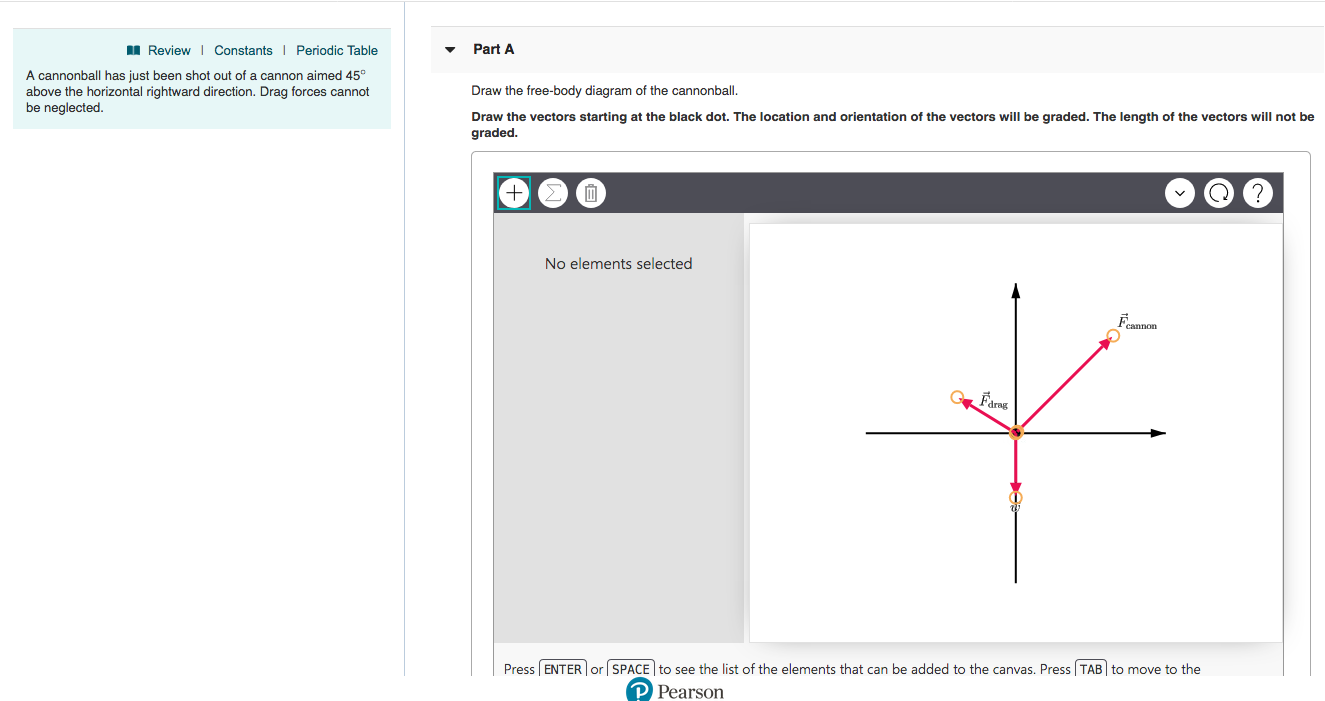Review Constants Periodic Table Part A A cannonball has just been shot out of a cannon aimed 45° above the horizontal rightward direction. Drag forces cannot be neglected Draw the free-body diagram of the cannonball. Draw the vectors starting at the black dot. The location and orientation of the vectors will be graded. The length of the vectors will not be graded No elements selected drag | Press | ENTER | or | SPACE to see the list of the elements that can be added to the canvas. Press | TABI to move to the Pearson
Review Constants Periodic Table Part A A cannonball has just been shot out of a cannon aimed 45° above the horizontal rightward direction. Drag forces cannot be neglected Draw the free-body diagram of the cannonball. Draw the vectors starting at the black dot. The location and orientation of the vectors will be graded. The length of the vectors will not be graded No elements selected drag | Press | ENTER | or | SPACE to see the list of the elements that can be added to the canvas. Press | TABI to move to the Pearson
University Physics Volume 1
18th Edition
ISBN:9781938168277
Author:William Moebs, Samuel J. Ling, Jeff Sanny
Publisher:William Moebs, Samuel J. Ling, Jeff Sanny
Chapter9: Linear Momentum And Collisions
Section: Chapter Questions
Problem 67P: Two particles of masses m1 and m2 move uniformly in different circles of radii R1 and R1 about the...
Related questions
Question
A cannonball has just been shot out of a cannon aimed 45∘ above the horizontal rightward direction. Drag forces cannot be neglected.
Which way does drag point? I thought it points opposite of the direction of the motion.

Transcribed Image Text:Review Constants Periodic Table
Part A
A cannonball has just been shot out of a cannon aimed 45°
above the horizontal rightward direction. Drag forces cannot
be neglected
Draw the free-body diagram of the cannonball.
Draw the vectors starting at the black dot. The location and orientation of the vectors will be graded. The length of the vectors will not be
graded
No elements selected
drag
| Press | ENTER | or | SPACE to see the list of the elements that can be added to the canvas. Press | TABI to move to the
Pearson
Expert Solution
This question has been solved!
Explore an expertly crafted, step-by-step solution for a thorough understanding of key concepts.
This is a popular solution!
Trending now
This is a popular solution!
Step by step
Solved in 3 steps with 1 images

Knowledge Booster
Learn more about
Need a deep-dive on the concept behind this application? Look no further. Learn more about this topic, physics and related others by exploring similar questions and additional content below.Recommended textbooks for you

University Physics Volume 1
Physics
ISBN:
9781938168277
Author:
William Moebs, Samuel J. Ling, Jeff Sanny
Publisher:
OpenStax - Rice University

Physics for Scientists and Engineers, Technology …
Physics
ISBN:
9781305116399
Author:
Raymond A. Serway, John W. Jewett
Publisher:
Cengage Learning

Classical Dynamics of Particles and Systems
Physics
ISBN:
9780534408961
Author:
Stephen T. Thornton, Jerry B. Marion
Publisher:
Cengage Learning

University Physics Volume 1
Physics
ISBN:
9781938168277
Author:
William Moebs, Samuel J. Ling, Jeff Sanny
Publisher:
OpenStax - Rice University

Physics for Scientists and Engineers, Technology …
Physics
ISBN:
9781305116399
Author:
Raymond A. Serway, John W. Jewett
Publisher:
Cengage Learning

Classical Dynamics of Particles and Systems
Physics
ISBN:
9780534408961
Author:
Stephen T. Thornton, Jerry B. Marion
Publisher:
Cengage Learning

Glencoe Physics: Principles and Problems, Student…
Physics
ISBN:
9780078807213
Author:
Paul W. Zitzewitz
Publisher:
Glencoe/McGraw-Hill

Physics for Scientists and Engineers
Physics
ISBN:
9781337553278
Author:
Raymond A. Serway, John W. Jewett
Publisher:
Cengage Learning

Physics for Scientists and Engineers with Modern …
Physics
ISBN:
9781337553292
Author:
Raymond A. Serway, John W. Jewett
Publisher:
Cengage Learning